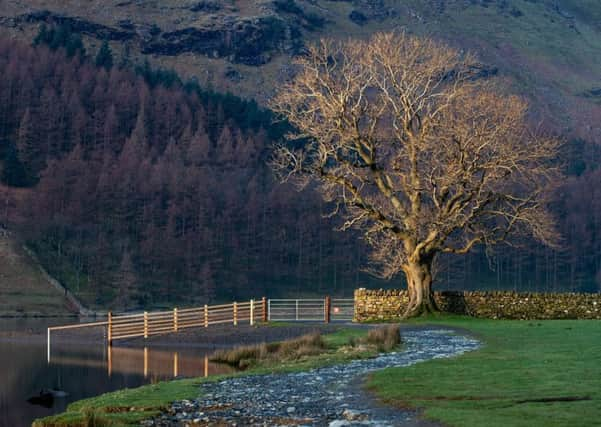Volatile weather patterns force farms to adapt amid ‘false spring’
This article contains affiliate links. We may earn a small commission on items purchased through this article, but that does not affect our editorial judgement.


Unprecedented warm temperatures in February during a remarkably dry winter to date follows a long period of drought-like conditions last summer.
Such mild recent conditions have provided an early opportunity for many farmers but some fear conditions could suddenly change and bring a severe weather event like last year’s Beast from the East.
Advertisement
Hide AdAdvertisement
Hide AdSome farmers have started drilling crops, at least a month earlier than usual, while lowland sheep farmers are turning out flocks to take advantage of the sunshine and signs of grass growth.
While a cold snap could damage those gains, equally, there is a fear that continued warm, dry conditions could lead to an even worse situation than that caused by last summer’s long hot spell.
Limited grass growth until late summer and into early autumn made for tight supplies of fodder to feed livestock over winter.
Rachel Hallos, an upland livestock farmer in Ripponden and West Riding county chairman at the National Farmers’ Union, said: “I’m having a lot of conversations with farmers who are getting very nervous. We are getting into a situation now where we need rain but when it comes, what’s going to happen?
Advertisement
Hide AdAdvertisement
Hide Ad“I’ve heard a lot of people are drilling, one farmer said he’d started 50 days earlier than usual, and it’s because they are worried they are going to miss their chance, the rain comes and it’s too late.”
She said the mild conditions had allowed for fencing and drainage work on her farm but she has just used her last batch of silage and so has resorted to feeding cattle with straw as an alternative.
She is wary of turning out livestock too early, saying: “People are turning out now but it’s a bit of a false spring. If we don’t get the rain, we are in a mess in terms of grass growth and the establishment of crops.”
Doncaster-based farmer Russell Toothill, who has been farming for 40 years, linked recent weather with his most productive ever lambing time. He suspects last year’s conditions have impacted the fertility of his flock.
Advertisement
Hide AdAdvertisement
Hide AdWhen he spoke to Country Week earlier this week, he had 50 ewes left from 350 to lamb. He said 50 per cent of the flock had produced either three, four or even five lambs.
“I’ve had an unprecedented number of lambs and strong lambs as well. Perhaps because they were short of grass all summer, when the grass grew it flushed them a bit,” he said.
When ewes produce triplets, one lamb is separated so it gets enough milk. Mr Toothill has far more triplets than he anticipated and so has hired a semi-automatic feeding machine for 75 lambs.
Ewes that have lambed are being put outside to make the most of the mild weather and the farmer said: “It’s been perfect weather to get them out but the concern is what are we going to get next? I have concerns about the coming summer, about drought and winter shortages again.”
Advertisement
Hide AdAdvertisement
Hide AdThe impact of last year’s drought on fodder, as well as some crop yields, has caused financial difficulties for some farms.
This week, dairy co-operative Arla, whose UK headquarters are in Leeds, confirmed it will use its 2018 net profit to make “drought payments” to its European farmer owners on March 8. Some £64m will be shared among its British farmer owners, in a move which comes after half-year results showed Arla’s UK net revenue rose by 2.3 per cent to £961m.
Arla dairy farmer John Banks runs a herd of 500 cows in York, producing five million litres of milk a year. He said the extreme conditions over the last year had caused uncertainty.
Advertisement
Hide AdAdvertisement
Hide Ad“With the weather becoming more unpredictable, the best way we can prepare our farm is by ensuring we’ve got key supplies in stock such as plenty of food and bedding for the animals,” he said.
“We introduced sand for our cows’ bedding a few years ago. They love it, because it’s really comfortable and it works for us as it has antibacterial properties, so it’s more hygienic.”
Another Arla farmer, Keighley-based Jonathan Sharp said the early spring means he can let his cattle outside to graze in early April, instead of May 1, as is tradition.
He said he is plans to avoid getting caught out if more drought-like conditions transpire this summer.
Advertisement
Hide AdAdvertisement
Hide Ad“We’ll be ensuring that our farm has plenty of water on site and we’ll be keeping our herd indoors if it gets too hot to keep them as cool and comfortable as possible,” he said.
Mrs Hallos added: “Farmers are adapting their traditional working practices because of the increasingly unpredictable weather. It’s all about trying to make our farms more resilient to extremes.”
A NEW EXTREME
The UK saw a new winter record temperatures set in two consecutive days, with a reading of 21.2 degrees at Kew Gardens in London, but wet and windy conditions were forecast for this weekend.
Mild temperatures at the start of the year saw The Woodland Trust receive more than 64 reports of an early spring in the first weeks of January alone.
The Climate Coalition recently warned about future British farming supplies due to the changes in the weather, with more than half of UK farms affected by a severe climactic event in the past decade.
